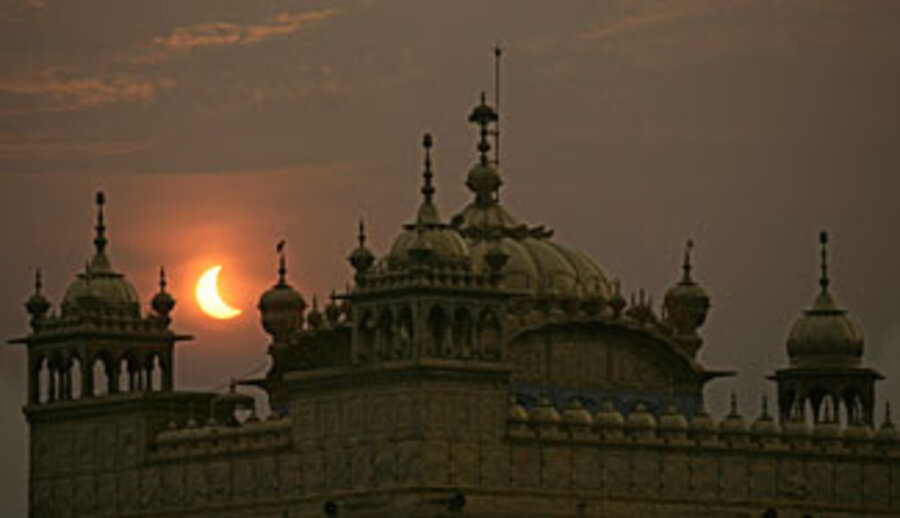A solar eclipse for the people
| Beijing
The solar eclipse that passed over Asia Wednesday – the longest of this century – was the 36th one Paul Maley has traveled the globe to see.
This time, he and his busload of eclipse-chasers fanned out around a half-built gas station outside Wuhan, in central China. As the moon passed in front of the sun, dogs barked and roosters crowed. Nocturnal flowers opened, only to close again minutes later. Fiery prominences shot from the aura of the sun shining behind the moon.
Dr. Maley – who runs the Astronomical Society of NASA's Johnson Space Center in Houston – has seen such wonders all before. But, he says, this eclipse was different, because millions of people got to see it.
"You could say that's what made this one special. It was probably viewed by more people than ever before," says Maley, who handed out glasses to protect onlookers from the ultraviolet rays. "Everybody seemed to have a really good time."
Eclipses often pass unnoticed
Solar eclipses typically are visible every six, 12, or 18 months – but can often only be glimpsed from the middle of the ocean. Maley's eclipse-chasing has taken him from Acapulco, where saw his first total solar eclipse in 1973, to the sparsely populated Gobi Desert in western China last year.
This time, hundreds of millions of people were able to watch the eclipse firsthand, walking into the mid-morning darkness as the eclipse passed over India, across the Himalayas and southeast China, then over Japan's southern islands.
The moon's shadow caused Asian megacities to go from bright to dim to dark in the middle of rush hour. Police came out in force on Shanghai street corners, and Chinese media warned drivers to stay focused.
'Like the sun was wearing a diamond ring'
Cities not shrouded in rain clouds were able to observe stars and planets when the moon obscured all but the sun's ringed aura for six minutes and 39 seconds.
"At 9:11 a.m., it was completely dark," says Xiao Wei, an office worker reached by telephone in Chongqing, southwest of Wuhan. "But around the sun, there was a ring and a light spot with white and red light, like the sun was wearing a diamond ring."
Up in the east-coast mountains of Zhejiang Province, Adam Rosenberg of Scottsdale, Ariz., was thrilled to observe his seventh eclipse. His previous six, starting in 1998, were seen from Aruba, Hungary, Zambia, Australia, Libya, and the Gobi Desert.
"I started going on a whim but got hooked," he says. "There's something primal about watching the sun go out."
His fellow eclipse-chasers hailed from Australia, New Zealand, Singapore, the United States, and the United Kingdom. Four of the 10 in their group were eclipse "virgins," Rosenberg says.
Cause for celebration
So, too, was their guide, Carol Fang, who works for Hangzhou-based Absolute China Tours, one of the dozens of travel companies offering tours of at least 10 days arranged around the astronomical event. The bill: about $1,300 a head.
Ms. Fang led her group to a reservoir in Anji county, where local officials roped off the mountaintop and charged 150 yuan ($22) per person.
Fang watched with thousands of local stargazers from a free, public spot down the mountain.
"It was very, very exciting," she says. "Everybody was quiet at first but then, as the full eclipse happened, everyone cheered. They couldn't help it."





